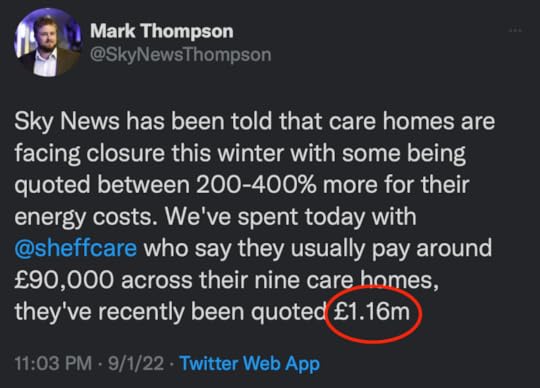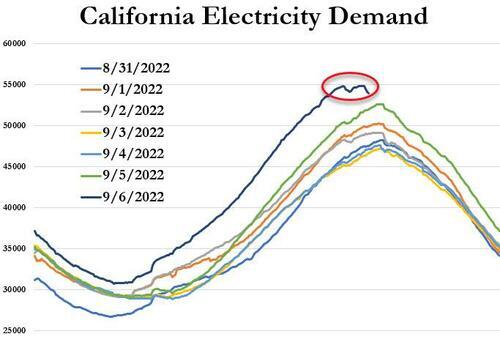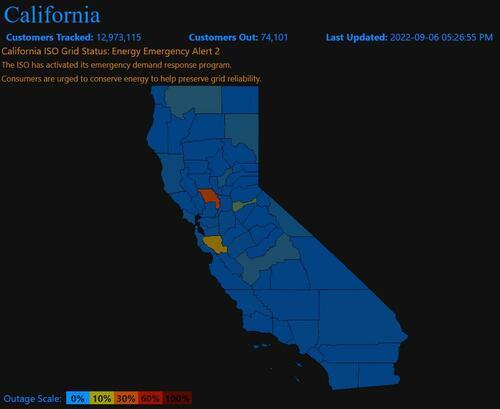Steve Bull's Blog, page 193
September 7, 2022
Nobody could have seen it coming
Eighteen months ago, the UK average annual combined gas and electricity bill was £1,287. Later this week, we expect to learn that it will rise to £3,582 in October and to £4,266 in January 2023. Not, in reality, that anybody is going to pay that amount. All but those at the very top of the income ladder will instead cut back on energy use, with those at the bottom forced to self-disconnect. The problem is far worse for business users, who are not “protected” by the price “cap” imposed by the regulator. Energy is often the third largest cost – after wages and taxes – to businesses which have already been struggling with higher input and debt-servicing costs. What this is pointing to is a major affordability crisis this winter, with growing concerns for public health and the likelihood of a recessionary wave of business insolvencies.
As with the 2008 crash, the Versailles-on-Thames establishment are keen to point out that “nobody could have seen it coming.” After all, “Putin’s invasion of Ukraine,” coming just as the economy was staggering out of a two-year pandemic – itself arriving just months after the UK finalised Brexit – amounts to a combination of events which would have been considered outlandish in a work of fiction… except that a work of partial fiction – a docudrama – accurately set out the main causes of the UK’s current energy woes eighteen years ago.
In 2003, BBC programme makers began work on a series called “If… ,” which aimed to explore the future crises which required political leaders to act immediately, using drama to make the point. The three series, which were broadcast between March 2004 and May 2006, tackled issues like the impact of obesity on public health, the growing disparity between rich and poor, and intergenerational conflict between the boomers and millennials…
…click on the above link to read the rest of the article…
Net zero is dead – so what now?
There is a deep irony that Europe’s wind turbine factories were among the first to close in the face of our growing energy crisis. Nevertheless, it goes a long way to demonstrating the fundamental flaw in the net zero project – while the harvested energy of the wind may be renewable, the technologies that do the harvesting are not. Indeed, these supposedly “green” technologies depend upon complex global supply chains powered by fossil fuels at every stage of their manufacture, transportation, deployment, maintenance, and decommissioning. But that inconvenient truth was never allowed to get in the way of the technocratic net zero fantasy – aka “the great reset,” “the green new deal,” or “the fourth industrial revolution.”
It wasn’t, you see, just us who were “energy blind.” Indeed, those at the bottom of the income ladder tend to be more aware of the importance of energy – including having enough calories to ward off hunger – than the technocrats and elites at the top of the pyramid, who tend to believe that they are perched up in the clouds solely due to their own efforts, rather than to having burned their way through a mountain of coal and an ocean of oil to generate their theoretical wealth. And so, they sold us this children’s story about how complexity and science don’t really matter, and that so long as we all wish hard enough, we could replace all of the coal, gas and oil with sunlight, wind and pixie dust. And in doing so, nothing would really change, and we would all own nothing but still live happily ever after.
…click on the above link to read the rest of the article…
By wis.dom project: Regress in Progress: My state of mind
 Dire Evolutionary Timeline by Blu
Dire Evolutionary Timeline by BluThis is an essay from reader wis.dom project who describes his painful personal journey of connecting dots to achieve awareness of our overshoot predicament.
I was born in 1969, at a time when everything still seemed possible. On July 20, two people walked on the moon, which is probably the greatest technological achievement of man to this day. In my youth, I devoured novels by Asimov, Clarke, Lem, Dick and Herbert. The galaxy’s colonization seemed within reach.
45 years later, I realized that I was a victim of mass hypnosis, what I refer to today as techno-utopia – a belief in the limitless human development, genius and almost divine uniqueness of Homo Sapiens. I realized that industrial civilization, like any other dissipative structure, is doomed to inevitable collapse.
In 1972 – 3 years after my birth, a book titled The Limits to Growth was released by the Club of Rome. It was the first scientifically compiled report analyzing future scenarios for humanity. It indicated that unlimited development is not possible on a finite planet. The book was published in 30 million copies and was one of the most popular at the time. Surprisingly, despite the wide range of my readings, the book did not appear on my horizon for a long time. As if it was covered by another intellectual “Säuberung”. In fact, it was the subject of an intellectual blitzkrieg and relatively quickly evaporated from the media circulation. I experienced this myself by talking to several university professors. Every one of them dismissed the LtG concept with a shrug and an unequivocal, non-debatable conclusion that the theory had long been discredited.
…click on the above link to read the rest of the article…
Stone Age Economics, Marshall Sahlins (1972)
Beginning as a presentation in 1966, what Sahlins challenged was the historic prejudice which dismissed the rights and value of ‘undeveloped’ societies and their ‘state of nature’.
Ramblinactivist’s ‘A Book in Five Minutes’:
No.16, 20th August 2022
View the YouTube video of this post
‘A Book in Five Minutes’ Index
‘A Book in Five Minutes’ No.16 Podcast:
Download podcast as an MP3 or an Ogg Vorbis file.
Given the various forms of public anguish about the ‘cost of living crisis’, I thought it would be a good time to do another three-part ‘special’ focussing on the nature of how we live our lives – both today, and in the distant past – to objectively question the basis of this ‘modern’ lifestyle.
The first book is Marshall Sahlins’, ‘Stone Age Economics’ – published fifty years ago in 1972.
‘Stone Age Economics’:First hardback edition, 1972. ISBN 9780-2020-1098-4.
First paperback edition, 1972. ISBN 9780-2020-1099-1.
Routledge revised paperback edition, 2017. ISBN 9781-1387-0261-5.
Free PDF of first edition, via Libcom.
Free text/PDF/epub of first edition, via Internet Archive.
Beginning with a presentation in 1966, ‘Notes on The Original Affluent Society’, what Sahlins challenged was the historic prejudice which dismissed the rights and value of ‘undeveloped’ societies and their ‘state of nature’ (I will not use the word, ‘primitive’, in this context as that is even more politically loaded).
The idea of ‘undeveloped’ societies lacking economic legitimacy, and therefore supremacy over their lands and resources, had been evolved by figures such as Hobbes and Locke in the Seventeenth Century; and was the basis of the justification which permitted the expropriation of land, and the enslavement of peoples, in Africa and the Americas under early European imperial expansion.
As Sahlins says:
“The familiar conception… makes assumptions peculiarly appropriate to market economies: that man’s wants are great, not to say infinite, whereas his means are limited, although improvable…
…click on the above link to read the rest of the article…
“Blackouts Imminent” – 75,000 Powerless As Record California Power Usage Sparks ‘Demand Response Event’
Update (2030ET): As was expected earlier, California power usage surged to a record high this afternoon raising the emergency status of the state’s electrical system to the highest possible level amid a blistering heat wave, which means rolling blackouts are imminent.
This triggered a “demand response event”…
And CA ISO is warning of more “blackouts imminent”.
“This is going to be so dicey,” Michael Wara, director of Stanford University’s climate and energy policy program, said earlier in the day.
“There’s a gap for two hours in the evening right now between available supply and projected demand.”
This farce for one of the most-taxed states comes just four days after President Biden’s Energy Secretary Jennifer Granholm praised the state’s green energy policies.
Granholm said that California was leading the nation in green energy development and praised its ability to shape national energy policy, according to an interview conducted by Fox 11 Los Angeles.
“I love the fact that California is unabashedly bold about (green) energy policy,” Granholm stated, calling the state as a green “leader” for the rest of the country.
“California’s boldness has … shaped our willingness in the federal government to move further and faster,” she said of California’s green energy policies.
California’s energy policy has currently left 75,000 Californians without power already…
And the state’s largest power company, PG&E Corp., said in a statement that it had notified about 525,000 homes and businesses that they could lose power for up to two hours.
So this is what the rest of America can look forward to?
* * *
Update (1700ET): As we warned about earlier, Califiornians are apparently not heeding officials’ warnings that they should sacrifice their comfort for the sake of whatever business or social-engineering plan is the new thing.
…click on the above link to read the rest of the article…
September 6, 2022
Russia Admits Weaponization Of Gas, Halts NS1 Shipments “Until Sanctions Lifted” As EU Prepares Response To Energy Crisis
Putin is done playing around.
Two days after Russia indefinitely halted nat gas supplies via the Nord Stream 1 pipeline for the amusing reason that there was an “oil leak” (shown below)…
… on Monday Russia finally admitted what everyone has known since February – namely that it has weaponized commodities in response to the West’s weaponization of currencies (as Zoltan Pozsar has said all along),when the Kremlin said that Russia’s gas supplies to Europe via the Nord Stream 1 pipeline will not resume in full until the “collective west” lifts sanctions against Moscow over its invasion of Ukraine.
Putin’s spokesman, Dmitry Peskov, blamed EU, UK, and Canadian sanctions for Russia’s failure to deliver gas through the key pipeline, which delivers gas to Germany from St Petersburg via the Baltic sea.
“The problems pumping gas came about because of the sanctions western countries introduced against our country and several companies,” Peskov said, according to the Interfax news agency. “There are no other reasons that could have caused this pumping problem.”
Peskov’s comments were the most stark demand yet by the Kremlin that the EU roll back its sanctions in exchange for Russia resuming gas deliveries to the continent. It also confirms that Russia no longer needs to pretend it needs to export commodities to Europe – after all it has more than enough demand in China and India – and is willing to give Europe just enough to rope to… well, you know the rest.
On Friday, Gazprom said it would halt gas supplies through Nord Stream 1 because of a technical fault, which it blamed on difficulties repairing German-made turbines in Canada…
…click on the above link to read the rest of the article…
September 5, 2022
Czech PM Blames Russian Propaganda For Mass Protests In Pragu
Czech Prime Minister Petr Fiala is blaming pro-Russian forces for mass demonstrations this weekend that saw tens of thousands of people protest against the government, the European Union and NATO amid soaring energy prices and inflation.
The “Czechia First” demonstration saw 70,000 people gather to protest the government in a development the Czech prime minister is blaming on elements influenced by Russian propaganda.
“It is clear that Russian propaganda and disinformation campaigns repeatedly appear on our territory and that someone is simply succumbing to them,” Fiala said, as reported by Euractiv.
Protesters, brought together by the Communist Party, the Freedom party, the Direct Democratic Party, and other groups labeled as “radical”–both far-left and far-right–called on the government to address soaring energy prices and the highest cost of living since the early 1990s for everything from housing to consumer goods.
Protesters called for a new deal with Russia for gas supplies, just a day after Moscow said natural gas flows through Nord Stream 1 to Europe that had been cut off for maintenance would not be restored on Saturday as scheduled, and would be delayed indefinitely.
Inflation has hit 17% and is marching towards 20% in the coming months, according to Fortune, citing the Czech central bank.
The mass protests also came a day after a no-confidence vote against the five-party coalition government failed.
While the prime minister blamed Russian influence, other coalition government officials warned against sidelining real economic issues facing the people.
News reports noted that some demonstrators donned T-shirts favoring Russian President Vladimir Putin and some carried anti-EU and anti-NATO posters.
…click on the above link to read the rest of the article…
‘Worst Yet to Come’ as Global Civil Unrest Index Hits All-Time High

An opposition activist shouts slogans holding up bread as he protests along with others against rising living costs, at the entrance of the president’s office in Colombo on March 15, 2022. (Photo: Ishara S. Kodikara/AFP via Getty Images)
‘Worst Yet to Come’ as Global Civil Unrest Index Hits All-Time High“Over the coming months, governments across the world are about to get an answer to a burning question: Will protests sparked by socioeconomic pressure transform into broader and more disruptive anti-government action?”The risk of civil unrest is rising in over 100 nations, with the “worst yet to come,” according to an analysis published Thursday by the U.K.-based consulting firm Verisk Maplecroft.
“With more than 80% of countries around the world seeing inflation above 6%, socioeconomic risks are reaching critical levels.”
Incorporating data going back to 2017, the latest update to the firm’s civil unrest index (CUI) shows that the last quarter of this year “saw more countries witness an increase in risks from civil unrest than at any time since the index was released,” the analysis states. “Out of 198 countries, 101 saw an increase in risk, compared with only 42 where the risk decreased.”
“In December 2020, we warned of a new era of civil unrest, projecting that 75 countries would see an increase in civil unrest risk by August 2022. The reality has been far worse, with 120 countries witnessing an increase in risk since then,” the firm pointed out.
“With more than 80% of countries around the world seeing inflation above 6%, socioeconomic risks are reaching critical levels,” the analysis explains. “Almost half of all the countries on the CUI are now categorized as high- or extreme-risk, and a large number of states are expected to experience a further deterioration over the next six months.”
In a separate index, measuring government stability within countries, the firm found that 42 nations saw an increased risk of having their governments challenged or toppled compared with 27 countries where it dropped…
…click on the above link to read the rest of the article…
5 Psychological Experiments That Explain the Modern World
The world is a confusing place. People do things that don’t make any sense, think things that aren’t supported by facts, endure things they do not need to endure, and viciously attack those who try to bring these things to their attention.
If you’ve ever wondered why, you’ve come to the right place.
Any casual reader of the alternate media landscape will eventually come up with a reference to Stanley Milgram, or Philip Zimbardo, the “Asch Experiment” or maybe all three.
“Cognitive Dissonance”, “Diffusion of Responsibility”, and “learned helplessness” are phrases that regularly do the rounds, but where do they come from and what they mean?
Well, here are the important psycho-social experiments that teach us about the way people think, but more than that they actually explain how our modern world works, and just how we got into this mess.
1. THE MILGRAM EXPERIMENTThe Experiment: Let’s start with the most famous. Beginning in 1963, Yale psychologist Stanley Milgram conducted a series of experiments now referred to as the Milgram Obedience Experiments.
The setting is simple, Subject A is told to conduct a memory test on Subject B, and administer electric shocks when he makes mistakes. Of course, Subject B does not exist, and the electric shocks are not real. Instead, actors would cry, ask for help or pretend to be unconscious, all the while Subject A would be encouraged to carry on administering the shocks.
The vast majority of subjects carried on with the test and gave the shocks, despite the distress of “Subject B”.
The Conclusion: In his paper on this experiment Stanley Milgram coined the term “diffusion of responsibility”, describing the psychological process by which a person can excuse or justify doing harm to someone if they believe it’s not really their fault, they won’t be held accountable, or they do not have a choice.
…click on the above link to read the rest of the article…
This Winter, Collapse Is Coming to Britain
Britain Is Standing at the Edge of Social Collapse’s Abyss — And It’s About to Jump
 Image via Mark Thompson on Twitter
Image via Mark Thompson on TwitterThese days, my British friends ask me the same question, with the same faint tinge of terror in their voices. “So. How bad is it going to be?” What they mean is…well, let me try to explain why they’re asking.
Right about now, Britain’s setting records. Not good ones. It’s the rich world’s worst performing country in a stunning multitude of regards — falling incomes, crashing economy, skyrocketing inflation, dwindling confidence and optimism. Twice as many people died in Britain this summer of Covid than they did last summer. They were mostly elderly people, and that’s a parable for what modern Britain’s become: a stunningly cruel, indifferent, embittered society, inured to the grim reality of its own collapse.
Britain is the world’s preeminent bellwether of social collapse at this point in history. No nation in the rich world — and barely any in the poor one, really — come close. The rest of the world is dusting itself off after a rough few years, and restarting the engines of progress. But in Britain? Well, the engines of regress are pumping. Literally — sewage into the rivers. What kind of country wants to cover itself in its own — never mind.
For some reason that the world can’t quite fathom, Britain has decided to turn itself a kind of Neo Victorian dystopia, by way of American style ultra libertarianism. Think about how baffling and strange this really is for a moment. The nation that was renowned for its NHS and BBC, which invented the idea of the public park and the modern public library and museum. Now? It’s the kind of place with would make Dickens entire cast of villains, from Uriah Heep to Fagin, cackle in morbid glee.
…click on the above link to read the rest of the article…







